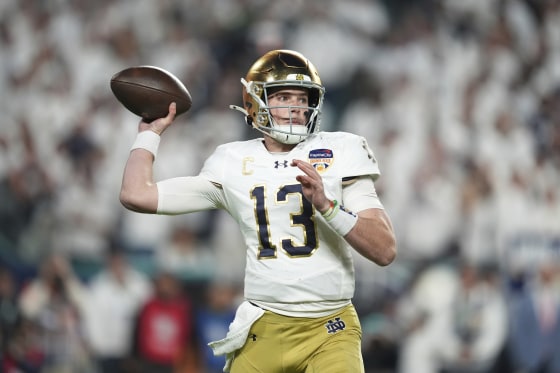ATLANTA — Four years ago, as Riley Leonard entered his senior season of high school football in Fairhope, Alabama, he received such little recruiting interest that the deeply religious 6-foot-4 quarterback began to consult a higher power in his search for a college scholarship.
“I remember sitting in my room and praying at night like, 'Jesus, Lord, would you please just give me something, give me an offer?” Leonard told reporters Saturday.
Duke University eventually answered that prayer, and a few years later, Leonard attended a famed summertime academy for quarterbacks in Louisiana run by Archie Manning, the former NFL quarterback and father of Super Bowl-winning quarterbacks Peyton and Eli. At the academy, Leonard roomed with Will Howard, the starting quarterback at Kansas State who, like Leonard, shared a similar backstory. Each was a three-star high school prospect, out of a possible five, who had been passed over by the country’s most tradition-rich schools and had instead proved himself as a starter at a middle-tier program.
At the camp, Leonard and Howard stayed up late talking.
“Life, and who we are as people and families and our goals in the future and things like that,” Leonard recalled. “So it was just a genuine conversation. We were both kind of underdogs at the time.”
No longer. One year after Leonard transferred from Duke to Notre Dame and Howard left Kansas State for Ohio State, one of the quarterbacks will leave Atlanta’s Mercedes-Benz Stadium on Monday night as a national champion.
“It’s kind of crazy now looking back at it, when we first met to where we are now, it’s cool,” Howard told reporters Saturday.
Quarterbacks traditionally reach the national college football final as either a former top recruit, or by waiting their turn as a backup, learning a school’s system for a season or two before taking over, and sometimes both. One-season superstars like Cam Newton, who led Auburn to the 2010 national title in his only season there, were the outliers.
Leonard and Howard, however, are the faces of a new era of college football — one in which winning a national championship has never been more accessible to a wider range of quarterbacks.
Aided by relaxed rules that now allow athletes who transfer schools to play immediately and the landmark shift in 2021 that allowed athletes to profit off their name, image and likeness (NIL), quarterbacks who prove their ability at smaller programs are now quickly snapped up at major powerhouses who, rather than entrust their success to an unproven, young starter, often opt to find their new QB in the transfer market.
Notre Dame and Ohio State’s coaches said they still rely on signing top high schoolers in making up their rosters, but when it came time to find a new starter at their most important position last winter, both opted for a transfer neither would have likely recruited out of high school.
“The foundation of our football program will be from high school recruiting, and we’ll minor in the transfer portal for specific needs,” Notre Dame coach Marcus Freeman said.
Leonard landed at Notre Dame two months after he sustained a season-ending injury against the Irish.
“I didn’t want anything to do with Notre Dame after that game,” Leonard said. “Shoot, here we are. It’s a crazy story.”
More from Sports
- Marcus Freeman starred at Ohio State. Now Notre Dame's coach is its biggest foe
- No debate: The 12-team College Football Playoff was a success
- Josh Allen, Bills defeat Ravens 27-25 to advance to AFC championship: Highlights
- The Lions and Commanders put on a slugfest for the ages. Here are the wildest highlights.
In this year’s 12-team College Football Playoff, the top seed, Oregon, was quarterbacked by Dillon Gabriel, a former three-star prospect from Hawaii whose production at Central Florida in the pre-NIL era led him to a transfer to Oklahoma in 2023, and then to Oregon this season.
Such transfers to top programs can expect a lucrative NIL package. Nebraska coach Matt Rhule estimated in 2023 that a “good” transfer quarterback could command $1 million to $2 million in NIL. Those figures are likely conservative; this fall, the nation’s top quarterback in the 2025 recruiting class reportedly agreed to an eight-figure deal to commit to Michigan.
“Yeah, the NIL is nice,” Howard said. “It’s a nice add-on, but it wasn’t why I came here.”
The move also includes a learning curve, however. Transfers arrive with talent, but not trust.
“I hated being in the transfer portal,” Leonard said. “It was honestly a very uncomfortable situation for me. I like to think of myself as a loyal person, but whenever I had to choose to leave Duke, I understood the repercussions that came with that.
"But whenever I got here, these guys just welcomed me in because I came here on crutches my first day here. I was actually on a scooter and crutches, and these guys welcomed me with open arms. So it wasn’t really me trusting them, it was more them trusting me because it’s hard to have a big-time transfer quarterback come in and he has three surgeries since the time he gets there — like that’s hard to trust.”
Said Howard: “Coming from a place where you’re there for four years and you’re very comfortable and you know everyone, coming into a new system where you have to kind of — I didn’t know anyone’s name. I’m just learning everybody’s name when I first got here.”
Few college football fans knew either quarterback’s name when they left high school. But on Monday, as the era of player movement persists across college sports, one will be known as a national champion.
